When it comes to living beings, it’s not always about whether you eat, it’s the quality of what you eat, combined with the ability to digest it. Marijuana plants are no exception. They rely on quality nutrients, either delivered through water or in the soil they grow in, but they also need to be able to digest them. A proper pH helps ensure your plants get the nutrients they need as well as ensuring the PPM for weed plant is correct.
About measuring PH and PPM
- What is pH?
- The effect of pH on Marijuana Plants
- Ensuring correct pH levels for your marijuana grow
- Measuring PPM for marijuana soil grows is equally important
- How to measure pH and PPM levels in Soil
- Measuring the pH and PPM in hydroponics and aeroponics
- The Best pH, TDS and EC values for marijuana plants
- Adjusting pH for your marijuana grow
This guide will explain why pH is important to marijuana growing, and how you can create the ideal pH for your plants.
What is pH?
The pH scale measures the degree of acidity or alkalinity of a solution. It ranges from 0 to 14, with 7 being the neutral point. The scale is based on logarithms. This explains why minor changes in pH can cause major consequences.
Those solutions that are below 7 are acidic, while those above it are alkali. A solution whose pH is 4 is about ten times the acidity of one with a pH of 5. However, a solution with a pH of 5 is a hundred times more acidic than one with a neutral pH.
The ‘’p’’ in pH is the symbol for a negative logarithm, and the ‘’h’’ is for Hydrogen. This is why it is written with a lowercase p, and a capital H. “pH” is an acronym for the potential (p) of the existence of the hydrogen ion (H+) in water. A pH of 7.0 has an equal balance between hydrogen ions (H+) and hydroxyl ions (OH-). Acidic solutions are represented by a pH of 1 to 6.9. The HCL in your stomach, for example, has a pH of 2. Alkaline solutions have a pH of 7.1 up to 14, such as in the small intestine which has a pH of 9.

Acids produce more Hydrogen ions. For instance, Hydrogen Chloride (HCl) dissolves into Hydrogen positive (H+) and Chloride negative (Cl-) ions. Neutral produces an equal number of (H+) and (OH-); for example, water (H20) will dissolve into one Hydrogen positive (H+) and one Hydroxyl negative (OH-) ion. Alkali solutions will create more hydroxyl ions than hydrogen ions, as is the case with Sodium Hydroxide which produces one Sodium positive (Na +) and one Hydroxyl negative (OH-) ion.
pH considers the concentration of Hydrogen ions, and because of this, we can calculate how much hydrogen is in a solution. In Hydrochloric acid, the concentration of Hydrogen ions is 0.01 while in water it is 0.0000001. In the solution of Sodium Hydroxide, it is 0.00000000000001. The pH derives from counting the decimal places from the first number. For example, the decimal places in 0.01 are 2, so the pH of the Hydrogen Chloride will be 2. This means that water will have a pH equal to 7, whereas Sodium Hydroxide will be an alkali with a pH of 14.
The lower the pH is, the higher the concentration of Hydrogen ions in the solutions’ dissolvent – meaning it is acidic. The inverse is true as well – the higher the pH, the lower the concentration of Hydrogen ions (or perhaps there are no hydrogen ions at all). There are also neutral solutions like water whose pH equals 7. Such solutions are neither acidic nor alkali.
Download my free Grow Bible for more more troubleshooting tips
The effect of pH on Marijuana Plants
pH is relevant for many natural processes, but in plants, the measure of the acidity and alkalinity levels in water is essential to survival. All living things on earth need water to survive. Plants (just like humans) require water and are made up of about 2/3 water. There are different types of “water,” however, and pH helps us measure them. Understanding the kind of water that your plants receive is just as important as understanding the nutritional value of the foods we eat and how it will affect our bodies.
You can think of pH like the hotness or coldness of your food. If your food is too hot, then you will burn your tongue or get heartburn. If it’s too cold, your teeth will hurt, and you’ll get a brain freeze. Finding the ideal pH balance is vital for marijuana plants to absorb their food and have good health.
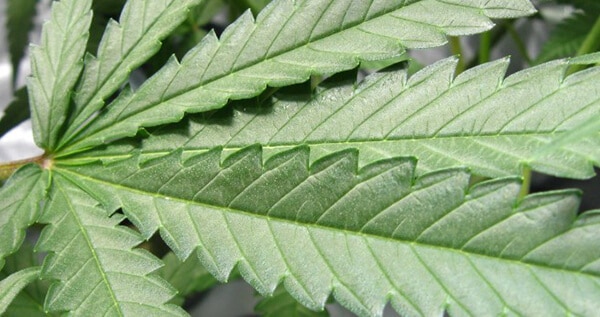
pH isn’t just about water, however, especially since water should be neutral. pH is highly relevant for nutrients as well since nutrients are delivered in water. In a non-soil medium, the solution pH of nutrients determines how well a marijuana plant can absorb them. To further complicate things, sometimes a marijuana plant’s uptake abilities can change. During its life, a plant may experience conditions such as environmental changes or infestations that affect its ability to absorb certain nutrients. By monitoring pH levels, a grower can recognize problems and address them before a plant suffers.
When growing in soil, pH provides a good measurement of the suitability of the soil and helps identify what needs to be done to prepare it for growing marijuana. It also reveals potential pH problems at the roots – which may have little to do with nutrients or the water it is receiving.
Ensuring correct pH levels for your marijuana grow
There are many ways to grow marijuana, and what you need to know about pH varies depending on your chosen methods. When looking to ensure the correct levels, you need to consider the pH at the roots, your water, and your nutrient solution. You should also remember that these numbers may not necessarily match.
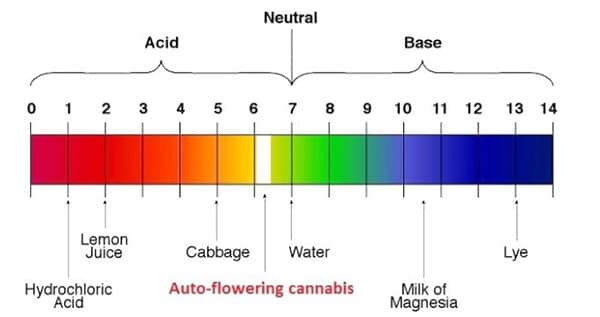
While understanding ideal pH levels is vital to growing healthy plants, choosing high-quality seeds is paramount. Grab the best marijuana seeds from my seed shop now.
Soil
Soil that has the proper level of pH and nutrients is more suited to growing healthy plants. It is an appropriate medium to use for beginners because it acts as a buffer and can mitigate most damage caused by mistakes. Slight problems with pH are not likely to damage your plant; however, big mistakes can be quite difficult to fix.
When preparing soil for growing marijuana, mix a sample of the soil with some distilled water and test its pH before planting.
Hydroponic
Hydroponic systems function by feeding all the nutrients a plant needs through mediums that are rather inert compared to soil. This effectively reduces the buffer zone that soil provides. Cocos or rock-wool can offer a small buffer for pH problems because they have their own pH level. Of course, you can compensate for pH problems by adjusting the nutrient solution.
Aeroponics
With aeroponics, there is no medium, which means there is no buffer. You won’t have to compensate for any medium so the nutrient solution must have the proper pH for your plant.
pH can impact how well your plants take in nutrients, but it isn’t the only variable that can influence this process. If it’s chilly in your grow room, the leaves of your plant won’t correctly evaporate moisture because of the low temperature. This evaporation is a crucial part of the vacuum cycle that draws nutrients up through the roots, and without it, your plant won’t pull in all the nutrients available in the soil.
This problem can quickly compound if not checked. Improper temperatures can cause nutrients to accumulate in the soil, lowering the pH around the root system. This high acidity in the roots limits the intake functions of the root hairs, which further exacerbates the difficulty your plant will have absorbing nutrients.
Measuring PPM for marijuana soil is equally important
Just like temperature can impact the absorption of nutrients in plants, other factors work alongside pH to keep your plants functioning well.
Plants use a process called “osmosis” to deliver nutrients through water, pulling them from the roots. Within the plant, nutrient levels are balanced with the water that’s in the plant and the water that’s around the roots. Nutrients are absorbed through the external water, and the plant discharges waste in the form of salts. Plants do not move, so they must be careful not to absorb their waste from the same water they absorb their nutrients. It is the same “don’t-shit-where-you-eat” logic that animals and humans live by.
To prevent this from happening, a grower can measure the number of minerals present in the solution they are providing and compare it to what is located around the roots. This is how you ensure plants are accessing the correct ratio of pure water and nutrient dense water, and not just the ‘dirty’ water sitting near their roots combined with more nutrient-dense water – leading to nutrient overload.
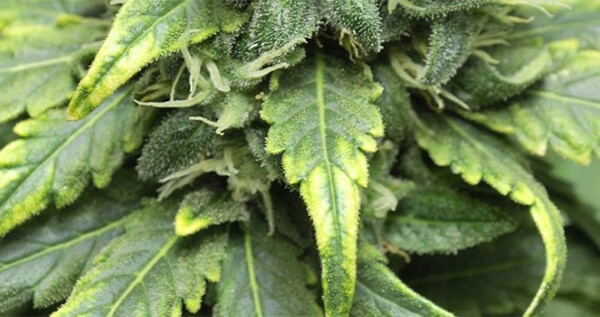
Nutrient density is measured by electrical conductivity or total dissolved solids. When you measure the pH level of your environment, you are measuring the electrical charge, that is, the ratio of positive or negative ions present. In much the same way, you can also measure the electric conductance, which tells you about the number of minerals present in the solution. The presence of these minerals is significant because plants need certain minerals to survive.
In soil, many of these minerals are present, but in hydroponic and aeroponic setups, they must be added using water. Water is an excellent conductor of electricity in part because of the minerals it contains. Even rainwater has some nutrients in it, but pure H2O will not efficiently conduct electricity. However, the more fertilizers, nutrients, or minerals are added to water, the better a conductor it becomes.
In terms of pH, more ions result in better conductivity. Most tap water contains the necessary ions (H+ and Cl-) for conducting electricity.
Just as with the pH, your best bet for measuring electric conductance is an electronic device. Results are given as total dissolved solids (TDS), conductivity factor (CF), Electrical conductivity (EC) or parts per million of specific elements (PPM).
Plants require diets that are as diverse as diets for people. Some plants may need larger meals that offer more nutrients for growth. By contrast, other plants might be “drowned” by too many nutrients and would require smaller meals. Understanding the ideal TDS (and PPM) values for marijuana plants will help them thrive since they’ll be able to absorb nutrients better while also preventing nutrient burn.
Download my free Grow Bible for more more troubleshooting tips
How to measure pH and PPM levels in Soil

If you’re planning to grow in soil, you should start by measuring its pH. Although soil acts as a buffering system for the water and nutrients your plants have access to, mistakes can still impact your plant – they just won’t do so as quickly. So, you should always measure the pH of your soil, to ensure that it is not too acidic.
It is also a good idea to measure the PPM (parts per million) or TDS (total dissolved solids), although it is not as important as pH, because of the nature of soil. However, there is no danger in being extra cautious; so, investing in a TDS meter is still a wise choice. Even though soil tends to act as a buffer for pH and support proper TDS levels, it’s still easy for nutrients to build up in it, causing a high TDS level and a low pH. If not checked, the TDS and pH at the root level could differ drastically from whatever values you have in the fertilizer solution you are feeding your plants. Obviously, this can cause trouble.
Even with the perfect nutrient, your plant’s environment can become unbalanced, that’s why you need to measure pH and TDS of your soil regularly— every two weeks works well. Don’t forget!
Measure The pH and TDS Of Your Soil Regularly from Robert Bergman (ILGM).
The process of checking pH is fairly simple. You can either use an electronic or chemical method of testing. Electronic testing is accurate but tends to be significantly more expensive. If you have a large growing operation, you’re probably going to want the electronic tester.
How to measure in three steps:
- Mix a 1:1 ratio of your soil from around the roots with demineralized water (water with TDS 0 and pH 7)
- Let this mixture sit for 24 hours, occasionally stirring
- Filter it and measure the TDS and pH
The devil’s in the details, so let’s go deeper with the step-by-step process you can use to measure the acidity and total dissolved solids of your soils. First, you are going to want to gather together everything you need:
- TDS and pH meter
- Demineralized water (water with TDS 0 and pH 7)
- 2 measuring containers (that can hold at least 6 ounces)
- 4 cloth or coffee filters
To start your test, remove 3 fluid ounces of soil from around the roots and mix it with 3 fluid ounces of demineralized water in one of your measuring containers. Let this mixture stand for 24 hours but continue to stir it occasionally. This way you will make sure all the nutrients dissolve entirely.
After everything in your solution has dissolved completely, pour it through a filter into the other measuring cup. Continue to repeat this process until you have a totally clear liquid. Now use your meter to determine the TDS and pH values of the soil your marijuana is growing in.
Growing marijuana with hydroponics can be challenging unless you know what you’re doing. Here’s our recommended hydroponics weed setup for those struggling to see results!
Measuring the pH and PPM in hydroponics and aeroponics
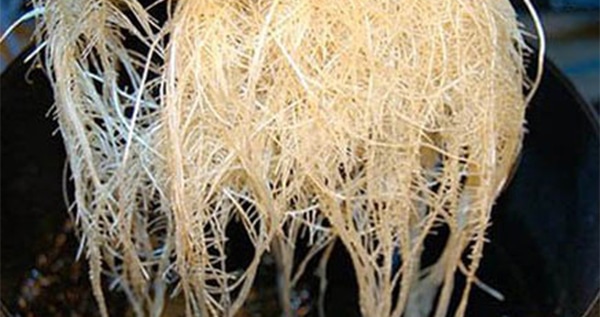
Because hydro- and aero- mediums do not provide a buffer like soil does, it’s important to focus on TDS/EC, and pH. Nutrients can be absorbed more easily at different TDS values, meaning you want to ensure those values while growing. Hydro- and aero- mediums use direct feeding, which means you have to carefully ensure that the plants won’t starve while also making sure that they don’t receive too many nutrients.
Inexpensive pH meters can be found at most garden centers, grow shops, and pond stores. My personal favorite is this one by Hanna Instruments. You can measure the concentration of ionic salts in the water with two different scales:
- Total Dissolved Solids (TDS) measured in Parts Per Million (PPM)
- Electrical Conductivity (EC)
In terms of the pH, if you haven’t invested too much into your hydroponics system and you don’t feel like measuring too often, you’ll be fine with the chemical test. If your pH rises too high, you can add some acid to balance it out, and tap water should correct a low pH. Ideally, you want to mix alimentary and phosphoric acid, which works well for both growth and flowering periods of your plant.
Keep in mind, however, that if you’re using reservoir or re-circulatory water systems, certain cleansing methods like reverse osmosis can drastically improve water quality. It effectively filters out surplus salt build-ups, ensuring that growers will be able to maintain their water quality and support the absorption of nutrients. All of this is sure to provide maximized results.
Download my free Grow Bible for more more troubleshooting tips
The Best pH, TDS and EC values for marijuana plants
There are ideal pH, TDS and EC values for growing the best marijuana plants. Once again, the pH scale ranges from 0-14, with zero being the most acidic (positively charged) and fourteen being the most basic/alkaline, (negatively charged). You’ll want the environment your marijuana plant is growing in to be stable at between 5-6, depending on the phase of growth it’s going through and its growing medium.
That being said, some nutrients are absorbed more fluidly at different pH levels. For instance, nitrogen (N) absorbs better at pH 6.0, while phosphorus (P) and potassium (K) are better at 6.25 and up. This may necessitate a change in pH values when you shift from vegetative state to flowering.
Once the plant is fully grown you will need to start thinking about flowering and harvest time. Our free little Harvest Guide will help you determine the best moment to cut your plants. Download it here.
The best TDS values fall between 750 ppm and 1500 ppm, depending on the maturation of your plant and the number of nutrients it can absorb. You can go higher, but you risk overwhelming your plants with nutrients.
When grown aeroponically or hydroponically, the pH level requirement lowers a bit. Cannabis plants growing in these mediums absorb nutrients most efficiently if the pH value of the solution is at least 5.2 (ideally 5.5). If the pH changes too drastically from this level, your plant can experience a wide array of issues and may stop growing entirely.
EC and pH Values by Week
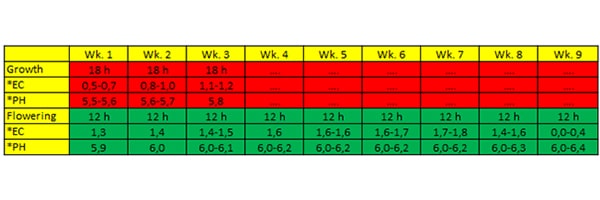
Some growers choose to measure electrical conductivity instead of total dissolved solids, especially when measuring the water at the roots. When your Cannabis plant is in its initial growth period, it should have an EC measuring 0.8-1.0; during flowering, the EC should be somewhere between 1.2-2.
If your EC levels rise too high in an active closed-circuit system, it probably means that your plants are absorbing too much water, and not absorbing the nutrients. You can lower EC by adding additional water. If EC levels drop too low, it probably means you need to add more nutrients.
When it comes to EC/PPM; It is critical to know that sometimes, less is more. Don’t overwhelm your plants because you are impatient and want to see them get bigger overnight.
EC Values for Hydroponics and Soil by Week

If you choose to measure by PPM, hydro growers should begin with a solution that has 500 PPM and increase by 50 every week. The pH should be close to 5.5, and at least 5.2. Any nutrient with less than 200 PPM will be very light.
TDS vs. EC
The terms TDS and EC are both used to measure the electrical conductivity of a liquid, but for marijuana growers either method will work. In fact, many TDS meters will give results in both EC and PPM. However, most feeding charts (used when working with nutrients) will use PPM.
If you have a device that delivers results in EC, you can convert it to PPM. You can also save yourself the headache and use a TDS meter.
Adjusting pH
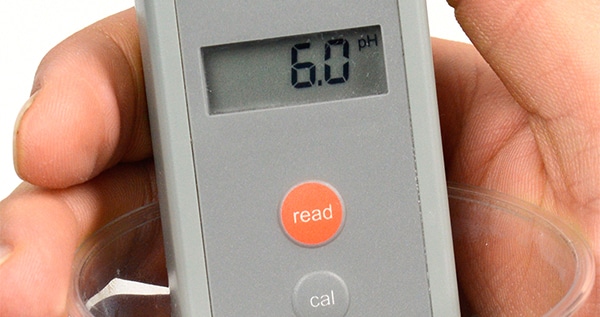
Once you learn how to monitor your pH, you need to keep a careful eye on it, because it significantly impacts the overall health and productivity of your plant. Small shifts in pH levels are unavoidable and normal, but you don’t want the fluctuations to be too large. If they are outside of the recommended levels, you don’t want them to remain that way for too long. Incorrect pH levels will always negatively influence the health of your plant.
What do you do if you don’t have the right levels? You make some adjustments! Maybe your pH is too low. The next time you give your plant water, use water with a pH value that is slightly higher than your current pH. This will raise the pH. The same method works for TDS levels. You can also use products designed to raise or lower pH such as pH down.
Start growing your own marijuana plants by choosing high-quality seeds from my wide seed selection.
If you need to adjust the pH level, don’t forget to return and check it in about two weeks. However, if you start to notice problems with the plant before that time, you should check the pH first, to see if an adjustment will fix it.
In the end, ensuring a high-quality growing environment for your plants requires some work, but it is vital for a high-yielding, potent harvest. By learning how to measure and adjust the pH of your plants, you are significantly improving the chance of your plant’s success.
Download our free Ganja Livity lifestyle guide to learn more about rolling perfect joints!
FAQ About Measuring PH and PPM
You need to measure the pH and TDS of your soil every two weeks.
To adjust the ppm, you’ll need to add more nutrients to your feeding solution.
Depending on your plant’s maturation and the number of nutrients it can absorb, the ppm should range from 750 ppm to 1500 ppm.
The post How to Measure PH and PPM for Your Marijuana Grow appeared first on I Love Growing Marijuana.
